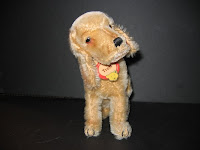Check out this note from Ainsley, who writes from Toronto.

 "I'm so glad I found your website - I have a feeling only a true collector will know the history of this Steiff (my mother had a small collection - ~15 animals). I have what I've been told is a very rare Steiff Tiger but I don't know anything else really about it. I took it to the Antiques Roadshow 15 years ago and they made an attempt at valuing it between $2,000 and $5,000 back then, depending on the auction. I am attaching some photos of the tiger and some details about him below:
"I'm so glad I found your website - I have a feeling only a true collector will know the history of this Steiff (my mother had a small collection - ~15 animals). I have what I've been told is a very rare Steiff Tiger but I don't know anything else really about it. I took it to the Antiques Roadshow 15 years ago and they made an attempt at valuing it between $2,000 and $5,000 back then, depending on the auction. I am attaching some photos of the tiger and some details about him below:- Mohair, hard stuffing
- glow in the dark eyes and teeth (mouth is open)
- pull string in between the shoulder blades creates a "growl" sound when pulled
- stands approximately 20" tall - forgot to measure when I took the photo and it's in storage now (I placed a pair of keys on the table so you can see the relative size/length)
- never a child's toy - in superb condition
- cast iron base and wheels with pull along cord
- he has his button in the ear but my mother pulled the tag off when it was given to her as a gift in the mid 1950's
Best, Ainsley"
Hi Ainsley. Yes, you have quite a lovely and unusual Steiff collectible. Steiff calls this "Reit Tiger" or Riding Tiger, and he was produced from 1956 through 1964. This timeline coincides with the information you provided about him. As his name implies, was designed as a ride-on toy for children, although his durable construction could support a full sized adult, at least when he was new. Reit Tiger is 50 cm, stuffed with excelsior, made from mohair with extensive black hand stenciled stripes, and has an internal metal frame for support. He glides along on disc wheels with rubber tires, has a pull string voice box, and a handled rope for pulling him along.
Besides his excellent condition, one thing Steiffgal finds particularly interesting about this piece is his open pink felt mouth with his four detailed, pointy, canine teeth. She can't help b

 ut notice the remarkable design similarity between Reit Tiger and another highly collectible (but much smaller) Steiff tiger produced from 1959 through 1961 called "Bengal." Bengal is sitting, has the same green eyes and open mouth and teeth design as Reit Tiger, a pink vertically stitched nose, and comes in three sizes: 14, 22, and 45 cm. Take a look at this picture of Bengal; what do you think? Definitely related... cousins at least!
ut notice the remarkable design similarity between Reit Tiger and another highly collectible (but much smaller) Steiff tiger produced from 1959 through 1961 called "Bengal." Bengal is sitting, has the same green eyes and open mouth and teeth design as Reit Tiger, a pink vertically stitched nose, and comes in three sizes: 14, 22, and 45 cm. Take a look at this picture of Bengal; what do you think? Definitely related... cousins at least!Tigers are a legacy species in the Steiff catalog, first appearing in 1915. The first "riding tiger" debuted in 1928. Prewar, Steiff produced about a dozen different tiger designs, but unlike your big beauty, none had open mouths with teeth (this design element debuted in 1953.) Post war, tigers are a contender for "king of the Steiff jungle", having been manufactured in more than forty unique models - including a puppet, sleeping animal, "lulac" style (long, playful dangling arms and legs), and life sized studio pieces.
As for Reit Tiger's worth... well, that's really hard to determine, further complicated by the overall poor economy, which has driven most collectible prices downward. Good for buyers, bad for sellers. However, given his excellent condition, age, and model rarity, you will always be able to find a buyer for him. Despite a thorough search, Steiffgal was not able to find any recent sales of comparable items, so it is impossible to give a hammer price range. Steiffgal would recommend monitoring eBay sales of 1950 - 1960 50 cm+ riding animals and/or studio pieces to get a better feeling for the market and Reit Tiger's possible value today.
Ainsley, Steiffgal hopes that this information about your toothy friend gives you enough to chew on... thanks for your note!
Have a question about one of your Steiff treasures? Let's talk! Click here to learn more.











































